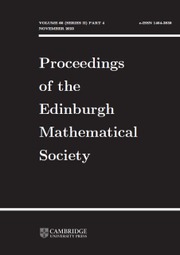No CrossRef data available.
Article contents
Abelianness and centrality in inverse semigroups
Published online by Cambridge University Press: 09 September 2025
Abstract
We adapt the abstract concepts of abelianness and centrality of universal algebra to the context of inverse semigroups. We characterize abelian and central congruences in terms of the corresponding congruence pairs. We relate centrality to conjugation in inverse semigroups. Subsequently, we prove that solvable and nilpotent inverse semigroups are groups.
MSC classification
Primary:
20M18: Inverse semigroups
Information
- Type
- Research Article
- Information
- Copyright
- © The Author(s), 2025. Published by Cambridge University Press on behalf of The Edinburgh Mathematical Society.
References
Almeida, J. and Shahzamanian, M. H., The rank of variants of nilpotent pseudovarieties, J. Algebra 609 (2022), 44–86.10.1016/j.jalgebra.2022.06.009CrossRefGoogle Scholar
Almeida, J., Shahzamanian, M. H. and Kufleitner, M., Nilpotency and strong nilpotency for finite semigroups, Quart. J. Math. 70(2): (2019), 619–648.10.1093/qmath/hay059CrossRefGoogle Scholar
Araújo, J., Kinyon, M. and Konieczny, J., Conjugacy in inverse semigroups, J. Algebra 533 (2019), 142–173.CrossRefGoogle Scholar
Bonatto, M. and Stanovský, D., Commutator theory for racks and quandles, J. Math. Soc. Japan 73(1): (2021), 41–75.10.2969/jmsj/83168316CrossRefGoogle Scholar
Freese, R. and McKenzie, R., Commutator theory for congruence modular varieties. In London Mathematical Society Lecture Notes, Volume 125, (Cambridge: Cambridge University Press, 1987)Google Scholar
Howie, J. M., Fundamentals of semigroup theory. In London Mathematical Society Monographs. New Series, Volume 12, (Oxford Science Publications. The Clarendon Press, Oxford University Press, New York, 1995).Google Scholar
Jespers, E. and Okninski, J., Nilpotent semigroups and semigroup algebras, J. Algebra 169(3): (1994), 984–1011.CrossRefGoogle Scholar
Kowol, G. and Mitsch, H., Nilpotent inverse semigroups with central idempotents, Trans. Amer. Math. Soc. 271(2): (1982), 437–449.CrossRefGoogle Scholar
Lallement, G., On nilpotency and residual finiteness in semigroups, Pacific J. Math. 42(3): (1972), 693–700.10.2140/pjm.1972.42.693CrossRefGoogle Scholar
Lawson, M. V., Inverse semigroups. The theory of partial symmetries, River Edge, NJ: World Sci. Publ. Co. Inc., 1998).CrossRefGoogle Scholar
Lipparini, P., Commutator theory without join-distributivity, Trans. Amer. Math. Soc. 346(1): (1994), 177–202.CrossRefGoogle Scholar
Mal’cev, A. I., Nilpotent semigroups. (Russian), Uch. Zap. Ivanov, Gos. Ped. Inst. 4 (1953), 107–111.Google Scholar
McCune, W., Prover9 and Mace4, version LADR–2009–11A, http://www.cs.unm.edu/mccune/prover9/.Google Scholar
McKenzie, R. N., The number of non-isomorphic models in quasi-varieties of semigroups, Algebra Univers. 16(2): (1983), 195–203.10.1007/BF01191768CrossRefGoogle Scholar
McKenzie, R. and Snow, J., Congruence modular varieties: commutator theory and its uses. In Structural Theory of automata, semigroups, and Universal algebra, NATO Sci. Ser. II Math. Phys. Chem., Volume 207, pp. 273–329 (Springer, Dordrecht, 2005).Google Scholar
Melʼnik, I.I, On the theory of generalized groups. (Russian). Theory of Semigroups and its applications, Volume 2, pp. 51–59 (Izdat. Saratov. Univ, Saratov, 1971)Google Scholar
Meldrum, J. D. P., Group theoretic results in Clifford semigroups, Acta Sci. Math. 52(1-2): (1988), 3–19.Google Scholar
Paterson, A. L. T., Groupoids, inverse semigroups, and their operator algebras. In Progress in Mathematics, Volume 170, (Birkhäuser, Boston, Inc., Boston, MA, 1999).Google Scholar
Petrich, M., The conjugate hull of an inverse semigroup, Glasgow Math. J. 21(2): (1980), 103–124.10.1017/S0017089500004067CrossRefGoogle Scholar
Petrich, M., Inverse semigroups, Pure and Applied Mathematics (New York). In A Wiley-Interscience Publication., (John Wiley & Sons, Inc, New York, 1984).Google Scholar
Piochi, B., Solvability and the permutation property in inverse semigroups, Semigroup Forum 42(1): (1991), 113–116.10.1007/BF02573411CrossRefGoogle Scholar
Preston, G., A note on representations of inverse semigroups, Proc. Amer. Math. Soc. 8 (1957), 1144–1147.10.1090/S0002-9939-1957-0091285-7CrossRefGoogle Scholar
Radović, J. and Mudrinski, N., Supernilpotent semigroups, Port. Math. 81(3-4): (2024), 307–320.10.4171/pm/2118CrossRefGoogle Scholar
Radović, J. Mudrinski, N., Commutators in completely simple semigroups, arXiv:2208.05237.Google Scholar
Stanovský, D. and Vojtěchovský, P., Commutator theory for loops, J. Algebra 399 (2014), 290–322.10.1016/j.jalgebra.2013.08.045CrossRefGoogle Scholar
Stanovský, D. and Vojtěchovský, P., Abelian extensions and solvable loops, Results Math. 66(3-4): (2014), 367–384.10.1007/s00025-014-0382-6CrossRefGoogle Scholar
Taylor, W., Some applications of the term condition Algebra Univers, 14(1) (1982), 11–24.CrossRefGoogle Scholar
Warne, R. J., Semigroups obeying the term condition, Algebra Universalis, 31(1): (1994), 113–123.CrossRefGoogle Scholar


